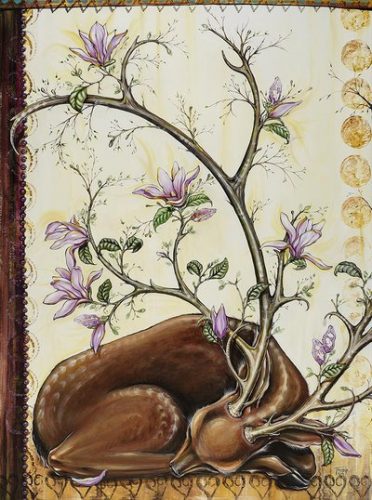
Shanna Trumbly was sitting in a cave roasting hotdogs when she saw the hummingbird. The Eugene artist was visiting Yachats with her family and, while on a hike, they had taken shelter from the rain.
“Out of the corner of my eye, I see this little bzzz,” she says, fluttering her hands. “There are no flowers around or anything. It was just like rock walls and the ocean … It was so bizarre because it wasn’t even a place where a hummingbird would be hanging out.” She adds, “Right when it flew off, the rain stopped.”
That moment confirmed for Trumbly an idea she had been toying with for months: using hummingbirds in the 2014 Oregon Country Fair poster. This is Trumbly’s second consecutive year creating the design for the ubiquitous and beloved Fair poster.
Last year’s poster was washed in watery blues with a hodgepodge of forest critters nestled into a border encircling the iconic Fair peach. This year, Trumbly wanted to do something different.
“This one, I wanted to create more warm colors — fire colors — and I wanted to create a kind of vaudeville feel with the banners,” she says. “But I wanted it to be really elegant and magical. I wanted it to feel like the ultimate invitation inside the peach.”
If you have yet to set your peepers on the poster, it features a bulbous peach, swollen and ripe, with a golden keyhole notched with a heart; three lime-hued hummingbirds nuzzle up to the fruit over a bed of feathery dandelions that have gone to seed.
Like all of her work, everything in the poster symbolizes an important theme in Trumbly’s life. The keyhole, for one, represents what it is not: the key.
“Ultimately, love is the key,” she says, referring to the devotion of Fair family and fairgoers. “It takes so much energy to create the Oregon Country Fair, but it’s something we all come together to create … Everybody who comes to the Fair, whether you’re on a committee or a crew or you’re a crafter, an artist, or whether you’re attending — every single person is part of creating that event.”
After Fair, where she will be selling her artwork at booth 952, Trumbly will turn her attention to two projects. The first is a student art mentorship program that is in its beginning stages. Trumbly has already mentored four students from local high schools, teaching them everything from stretching canvas to making their art marketable and, eventually, she’d like to work with three to five students at a time.
The second project, a book — One Thousand Tiny Scrolls, has been in the works for some time.
“It’s a larger coffee table-style book of all of my art with flash stories and poetry to go along with each of the images,” she says. The stories will be provided by Kelli Allen, a Lindenwood University English and humanities professor who was gifted Trumbly’s work by a friend. Allen in turn wrote a little tale about the painting, “The Queen and the Beet,” and sent it back to her friend, who sent it on to Trumbly.
“After reading this story, I felt that, in that moment, my painting was finally complete,” Trumbly says. “It brought so much light to the image that I had created but I didn’t even know that the story existed within my painting.”
Trumbly will be launching a Kickstarter to raise $30,000 for the book project this autumn.